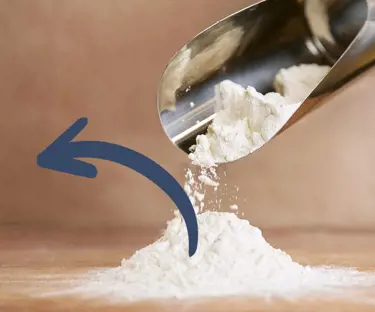During the past two to three years, there has been a significant change in the protein-as-an-ingredient landscape. Authors and influencers alongside US consumers and food providers have lead the change. Today, it’s possible to find supermarket aisles dedicated to protein-enriched foods and tubs of protein supplement touting a myriad of applications beyond the traditional shake. It’s all part of a wave that brings with it a completely new way of thinking about protein, about food, and about nutrition in general. But there is still change left to made. This blog post explores the strides we’ve made, the obstacles still ahead, and what we can do to further promote protein powder not as a bodybuilder’s supplement but as a nutrition-dense ingredient with benefit to all.
Protein: For men only
Protein powders are on a journey that began in the seventies and eighties and which is continuing to unfold over the years. Back in the early days, protein powder was regarded strictly as a muscle-building supplement for men. Sold in large tubs and purchased by men seeking a Schwarzenegger-style body, protein was marketed by selling men a fantasy: “drink this shake to put on muscle, and you too can have the body of your dreams.”
Women, on the other hand, were nowhere to be seen in protein marketing materials until many years later. This single-minded product image made its mark on broad consumer perceptions of protein powder as being associated with bodybuilding in general and mass-building supplements in particular– an image that has persisted ever since.
In the last few years, however, a distinct shift has begun to alter this otherwise monolithic panorama. People outside of bodybuilding circles have begun to ‘think outside the shake’ by adding protein powder to home recipes in order to enrich their meals and snacks. But in order for everyone to truly benefit from protein powders, we must actively continue topple several myths and misconceptions.
My journey
My journey in the world of protein powder began in my childhood, sparked by a father who combined his gym workouts with helpings of protein mixed in water or milk. I became interested in protein powder as a healthy and nutrition-dense ingredient to complement my active lifestyle. I used protein powders not to make shakes but to make muffins, pizza, cakes, cookies, pancakes and the like. I turned foods traditionally considered to be high-sugar treats, dessert, or ‘junk food’ into healthy and delicious high-protein, low-sugar, and high-fibre meals and snacks.
Cooking this way was a passion and I was later encouraged by friends to pursue it as a means of escaping the long hours of writing my PhD thesis almost a decade ago. That passion turned to two internationally-published cookbooks and a website with over 1,500 original protein powder recipes: proteinpow.com. Firmly focused on protein powder-powered food and beverage ideas, my books’ and website’s mission was – and remains - to make simple, nutritious, and protein-packed foods enjoyable and accessible to everyone, at every occasion, at every walk of life.
For me, a core founding idea was that adding the benefits of protein to one’s diet shouldn’t be a matter of mixing up and gulping down a scoop of some product with milk or water, often with a grimace at the lab-concocted taste. Equally, protein powder shouldn’t be something that is only considered to be of value to people trying to build their muscle mass or lose weight.
With that belief in tow, I carried out many, many experiments with recipe after recipe, challenging existing protein powder-containing recipes, which in the early days tended to always produce unappetizing results. For over 15 years now, I have focused on making foods that are just as enjoyable as their nutritionally-void counterparts, but which contain a higher protein content for the benefit of people from all walks of life. For me, making healthy protein-enriched foods appealing to a broader section of the population is all about combining attractive presentation with easy-to-find natural ingredients and accurate, factual information.
Social media and the normalization of protein powder as an ingredient
The rise of Instagram has played a key role in popularizing the idea of protein powder as a food ingredient with mass-market appeal, as opposed to a niche muscle-building supplement. It’s not that Instagrammers, as a group, are particularly protein powder-focused. It is just that Instagram, as a platform, makes it easy to share high-quality, attractively-presented photographs of foods made with protein powder and other healthy ingredients. By using protein powder in the kitchen, Instagrammers are helping to normalize the idea of protein powders being suitable for cooking and ideal for creating delicious meals and snacks. A simple search for #proteinpancake or #proteincake, today, will bring up tens of thousands of posts and recipes featuring protein powder as a food ingredient. Seeing people using protein to create appetizing foods makes it simpler to convey to a perhaps skeptical audience that, hey, protein powders aren’t just a grin-and-bear-it supplement, the basis to a post-workout shake, or a mysterious blend of muscle-building ingredients.
Almost there?
We are not yet at the point where protein powder is considered an ordinary household ingredient, especially not in Europe. Truth be told, that’s likely to be some years away. Already now, however, protein powder for bodybuilding has become a niche market instead of its stronghold – and women’s protein needs are now firmly in the picture, leading more and more women to purchase and consume protein and include it a part of their daily diet. Protein powder suppliers are increasingly promoting their products with a ‘cooking’ or ‘recipe’ angle too – eschewing imagery of lean fitness models on their labels and marketing material. Yet there are still many issues to overcome, namely in the way in which protein is marketed, promoted, and, as I will discuss in my next blog post.
This blog contains material and information intended for B2B customers, suppliers and distributors, and is not intended as information to the final consumers.


